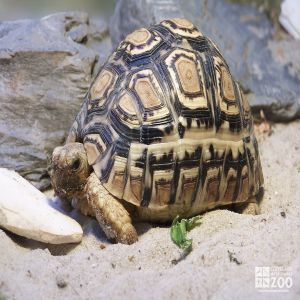Leopard Tortoise
[Stigmochelys pardalis]

The Leopard Tortoise averages about 2 feet long and weighs about 70 pounds, but there is a wide range of sizes. It has a highly domed carapace without a definite margin. The coloration is usually a tawny yellow or buff. Younger specimens have an unbroken black line around each scute. Older specimens have black spots or sometimes very dense broken radiations. Marking vary with the latitude and elevation; those above 6,000 feet are larger and have more distinct markings than those below 4,000 feet. The large forelegs are covered with horny plates.
Share:
Range
The range of the leopard tortoise is S.W. Africa.
Habitat
Leopard tortoises inhabit savannas with abundant vegetation.
Conservation Status
Least ConcernPrimary Threats
Gestation
Gestation in leopard tortoises is 8 to 18 months.
Litter
Leopard tortoises have litter of 5 to 30 or more.
Behavior
Leopard tortoise males compete with females in shoving matches until one is overturned. Females may also ram males or other females. When a captive individual is suffering from a calcium deficiency, indicated by a soft shell, they will eat the bones of small animals, but mineral supplements are easier.
Reproduction
During copulation the leopard tortoise male utters a loud husky cry. Females nest in the spring season (September-October) after urinating on the ground to soften it. The depressions are not very deep. Eggs are hard shelled spheres about 1.5 inches in diameter. If many eggs are to be laid, the female will separate the layers of eggs with dirt. Size and number of eggs varies with locality. Their chief predators are hawks and crows.
Wild Diet
Watermelon, fallen fruit, grass, toadstools, thistles, prickly pear, pumpkins, beans
